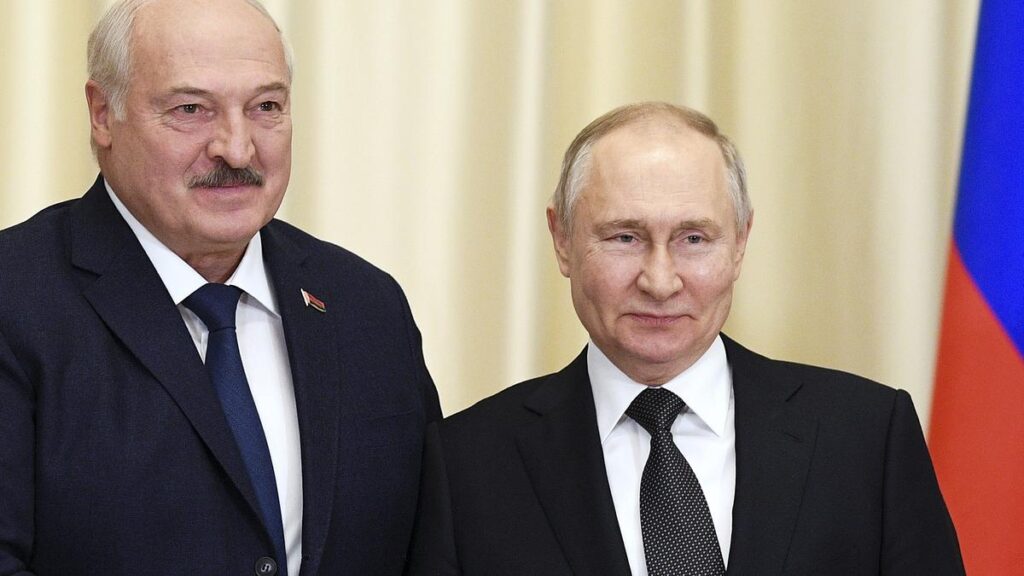Russian President Vladimir Putin and Belarussian President Alexander Lukashenko at the Novo-Ogaryovo state residence, outside Moscow, Russia on February 17.
| Photo Credit: AP
The story so far: In the latest escalation to the Russia-Ukraine war, Russian President Vladimir Putin announced last Saturday that Russia plans to station tactical nuclear weapons in Belarus. Tactical nuclear weapons refer to small nuclear warheads and delivery systems meant for use on the battlefield or for limited strikes.
Why the sudden announcement?
Mr. Putin said the announcement was prompted by the U.K.’s decision last week to supply armour-piercing rounds containing depleted uranium to Ukraine. Depleted uranium munitions augment the ability to overcome defences on tanks and have been described by the United Nations Environment Programme (UNEP) as “chemically and radiologically toxic heavy metal”. Russia claims that the positioning of tactical nuclear weapons in Belarus by Russia does not violate any international agreements that Moscow has signed because the control over the weapons would remain with Russia just as the U.S. retains control over its nuclear weapons on its allies’ territories. Moreover, there have been no arms control agreements between the U.S. and Russia on tactical nuclear weapons unlike in the case of strategic nuclear weapons. As Mr. Putin has said, “The U.S. has been doing this for decades. They have long placed their tactical nuclear weapons on the territory of their allies”, referring to U.S. nuclear weapons stationed in Belgium, Germany, Italy, the Netherlands, and Turkey.
Interestingly, the announcement contradicts the joint statement made by Mr. Putin and Chinese President Xi Jinping last week where they asked nuclear states to refrain from deploying nuclear weapons abroad. Russia has already helped Belarus upgrade its warplanes so that they can carry nuclear weapons. It is for the first time ever that Russia is deploying nuclear weapons outside its borders. Stationing such weapons in Belarus will enable Russia to carry out strikes easier and faster.
Why Belarus?
A former Soviet state, which like Kazakhstan and Ukraine handed over its nuclear weapons to Russia after the dissolution of the Soviet Union, Belarus has developed close military and political ties with Russia. It is one of the closest and few remaining allies of Russia. It is predominantly Orthodox like Russia with its population almost entirely-Russian speaking. There are also only a few border controls between the two countries. Belarus is a member of the Russian-led military alliance, the Collective Security Treaty Organization, as well as the Eurasian Economic Union. Russia leases two military installations in Belarus, both inherited from Soviet times. Moreover, Belarus gets subsidised oil and natural gas imports from Russia. As was the case with Ukraine, Russia wants to keep Belarus in its sphere of influence and therefore supports the regime of Belorussian President Alexander Lukashenko (often dubbed ‘Europe’s last dictator’), which is seen as friendly by Russia.
Belarus’ geo-strategic position, between Russia and Ukraine and between Russia and Poland, makes it very important for Russia. It also shares borders with three NATO members — Lithuania, Latvia, and Poland. For long, Belarus has been used as a forward base by Russia for power projection, to give it strategic depth. In fact, Belarus has been used as a launchpad by Russia to send troops and launch strikes in the ongoing war. However, Russia-Belarus relations have had their fair share of trouble.
In 2014, Belarus refused to acknowledge the annexation of Crimea by Russia and even hosted the Minsk talks. It also resisted pressure from Russia to host a permanent military base. However, all this changed in 2020 when Belarus was rocked by anti-government protests following what is widely seen as rigged Presidential elections. Mr. Lukashenko was isolated by the West while Russia helped him with a $1.5 billion loan, accepting the results of the elections and promising to intervene if required. The protests were suppressed brutally and a referendum in February 2022 changed the country’s Constitution which specified that Belarus would be a nuclear-free zone and would remain neutral. However, in March 2021, Belarus had already agreed to the presence of a joint Belarusian-Russian military unit on its territory, effectively ending its neutrality. Since the outbreak of the Russia-Ukraine war, Belarus has time and again supported Russia during voting at the UN General Assembly resolutions. So, now Mr. Putin sees Mr. Lukashenko as a dependable ally. Belarus, on its part, is happy about Putin’s announcement as it says it has long wanted nuclear weapons because of Western pressure aimed at changing its political and geopolitical trajectory. Minsk says that it needs these weapons to counter NATO’s military build-up near its borders.
What lies ahead?
The latest move by the Kremlin clearly escalates the Russia-Ukraine war to an entirely new dimension — the nuclear realm — by bringing tactical nuclear weapons literally next door to NATO members. It is probably also meant to dissuade the West from giving more advanced weapons to Ukraine. But it also gives the West an opportunity to use this pretext to further escalate the war. The move does not bode well for peace.
The writer teaches International Relations at the Central University of Kerala
